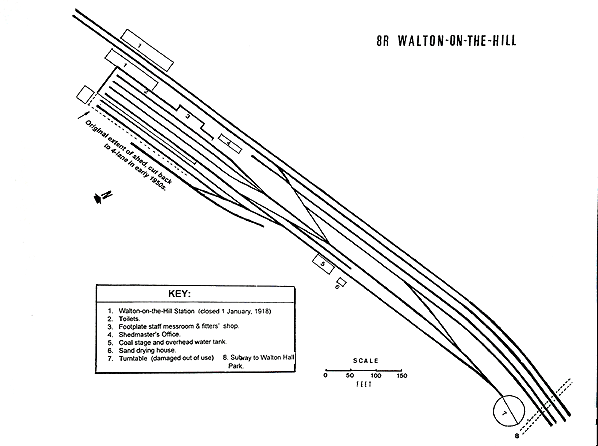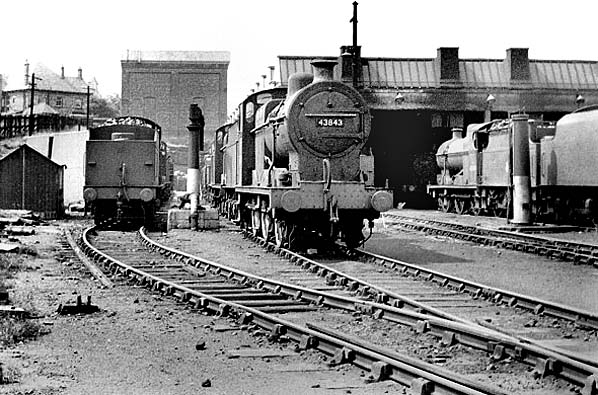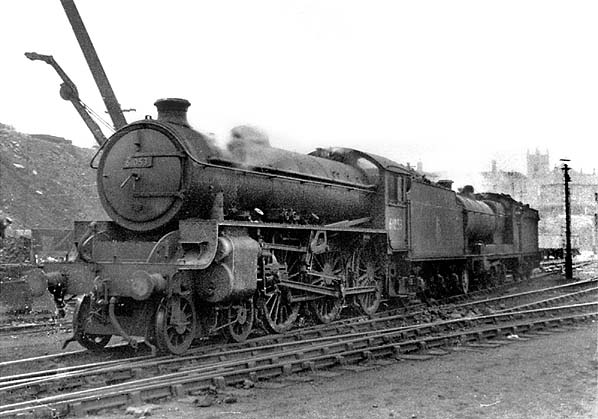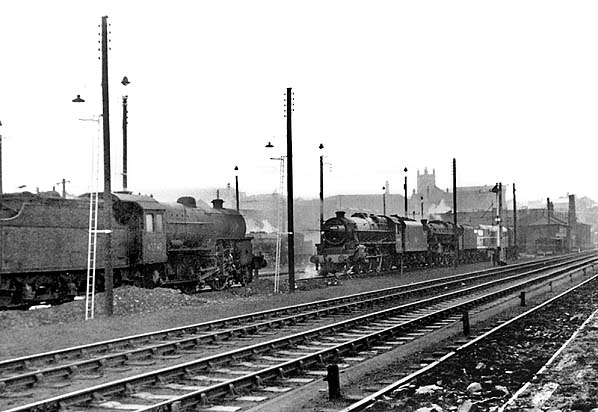hill_old8.jpg)
Walton-on-the-Hill locomotive shed looking south-west on 21 July 1957.
Photo by Jim Peden from the Roger Griffiths collection
The Cheshire Lines Committee (CLC) opened the North Liverpool Extension Line railway and its associated Huskisson branch from Halewood to Walton on the 1 December 1879. The CLC was a joint railway consisting of three partners: the Manchester, Sheffield & Lincolnshire Railway (MS&LR), the Midland Railway (MR) and the Great Northern Railway (GNR). A station was provided at Walton, which was called Walton-on-the-Hill. The line was authorised on 30 July 1874 as the North Liverpool Extension Line, and it was built so that the CLC could gain access to the rapidly developing deep water docks of north Liverpool.
Walton-on-the-Hill was only a temporary terminus for the line, and with the completion of three tunnels between Walton and Kirkdale it opened to Huskisson for goods services on the 1 July 1880. On the same day a line opened from what became known as Fazakerley West Junction to Fazakerley North Junction which provided direct access to Aintree (the northern end of the North Liverpool Extension Line). This created a triangle of lines north-east of Walton-on-the-Hill which enabled trains to travel in any direction without having to reverse. Sidings were laid out within, and adjacent to, the main lines. The official name of the triangle and the sidings within it was the Fazakerley triangle; however, locally it was almost always referred to as the Walton Triangle.
To serve the sidings and the goods depot at Huskisson the CLC opened Walton-on-the-Hill engine shed on13 May 1881. At the time of opening the shed had four engine roads; two were allocated to the MS&LR and two to the GNR. The main shed building was south-east of the line, adjacent to Walton-on-the-Hill station. At its south-western end the shed was in a cutting with sheer sandstone walls. Access for its employees was via the station. Beyond the shed building, sidings and lines ran in a north-east direction, parallel to the Huskisson branch, towards a coaling shed and, beyond that, a turntable. At the north-eastern end the lines and turntable were on an embankment. Just beyond the shed boundary was Walton Hall Park, and a footpath passed from it northwards in a tunnel.
Adjacent to the actual locomotive shed and next to the Huskisson branch were brick buildings that housed the shed master’s office, staff facilities and a fitters’ workshop.
The CLC had no locomotives of its own. For services within the CLC network motive power was provided by the MS&LR; for those beyond the network onto partners’ lines, the partners provided their own motive power.
Within four years there was insufficient space for the locomotives needed to work the local area, so the shed was enlarged to six roads in 1885. By this date the MR had opened a branch to Langton Dock from a point just north of Fazakerley North Junction. To work this branch the MR based its own locomotives at Walton-on-the-Hill. The Shed was given the Code WAL by the MSLR and 19A by the MR; it was a sub-shed of Brunswick.
In 1897 the MSLR renamed itself the Great Central Railway (GCR).
Typically inbound trains from distant locations to Huskisson Goods station would stop at Walton-on-the-Hill station and the locomotive crew would be relieved. A fresh crew would then work the train to Huskisson and bring the engine back to Walton for servicing. They would then work an engine back to Huskisson, and it would work an outbound train. The crew would be relieved at Walton-on-the-Hill station and a fresh crew would take the engine forward.

Walton-on-the-Hill Locomotive Shed shown on a 1893 map.
Walton-on-the-Hill shed was not only responsible for moving trains in and out Huskisson and the north dock system: its train crews were also rostered to long distance goods services. The MR operated long-distance goods trains from Walton-on-the-Hill to Carlisle, Sheffield, Nottingham and Rowsley. Many engines from far-away locations visited Walton for servicing, especially during ‘Grand National’ races at Aintree. Trains came onto the CLC North Liverpool Line from all over the country, and the locomotives were turned and serviced at Walton-on-the-Hill.
In 1923 the London and North Eastern Railway (LNER) took over the GCR and the GNR whilst the London Midland Scottish Railway (LMS) took over the MR. This gave the LNER a two-thirds share in the CLC and the LMS a one-third share. At Walton-on-the-Hill shed the two companies were allocated three shed roads each. The LMS allocated the shed code 23F to Walton-on-the-Hill; the LNER continued to use the WAL code.
The shed remained very busy throughout the 1920s and 1930s. Although primarily a goods shed a couple of passenger engines were based at Walton-on-the-Hill in this period to service the Aintree to Liverpool Central and Manchester Central services. Over twenty main line goods departures left Walton-on-the-Hill each weekday throughout the 1930s. From September 1936 the LMS stopped posting locomotives to Walton-on-the-Hill leaving it completely in the hands of the LNER.
During the Second World War Walton-on-the-Hill shed was extremely busy as the Liverpool Docks became the key point of entry for goods coming into Britain from the Americas. There were regular turns to Manchester Central, Southport Lord Street and Godley; there was even a goods train to Wrexham. In 1946 Walton-on-the-Hill had sixteen locomotives allocated to it.
On 1 January 1948 Walton-on-the-Hill Shed became part of the nationalised British Railways (London Midland Region) and from May 1949 they gave it the shed code 13F. A year later on 22 May 1950 the code was changed to 27E.
Since 1946 there had been numerous complaints from locomotive crews about the condition of the mess facilities and toilets at the shed. Staff were concerned that the rest areas had become insanitary: pigeons were entering the toilets and mess room and fouling them. At a meeting held with Railway Executive representatives from Euston on 11 September 1951 the issues were voiced and recorded. At the same time the condition of the coaling facilities was raised. They afforded little shelter and accidents had occurred there. Following the meeting improvements were made. In 1952 BR re-roofed the shed and they reduced it to four roads; they also replaced the smoke chutes and the interior lighting. The mess facilities were improved, and repairs were made to the coaling shed roof.
Locomotive on Shed
3 February 1963 |
Locomotive Type |
Locomotive on Shed
3 February 1963 |
Locomotive Type |
| 42054 |
Fairburn 4MT 2-6-4T (Ex LMS) |
44462 |
Fowler 4F 0-6-0 (Ex LMS) |
| 42540 |
Stanier 4MT 2-6-4T (Ex LMS) |
44481 |
Fowler 4F 0-6-0 (Ex LMS) |
| 42617 |
Stanier 4MT 2-6-4T (Ex LMS) |
44933 |
Stanier 5MT 4-6-0 (Ex LMS) |
| 42793 |
Hughes-Fowler 6P/5F 2-6-0 (Ex LMS) |
47225 |
Johnson 3F 0-6-0T (Ex MR) |
| 44042 |
Fowler 4F 0-6-0 (Ex LMS) |
47228 |
Johnson 3F 0-6-0T (Ex MR) |
| 44124 |
Fowler 4F 0-6-0 (Ex LMS) |
47235 |
Johnson 3F 0-6-0T (Ex MR) |
| 44177 |
Fowler 4F 0-6-0 (Ex LMS) |
47327 |
Fowler 3F 0-6-0T (Ex LMS) |
| 44188 |
Fowler 4F 0-6-0 (Ex LMS) |
47681 |
Fowler 3F 0-6-0T (Ex LMS) |
| 48608 |
Stanier 8F 2-8-0 (Ex LMS) |
90724 |
W-D 8F 2.8.0 (Ex War Department) |
In 1952 there were still 12 main line goods services that were the responsibility of Walton-on-the-Hill shed and numerous local trip workings and shunting turns. Little changed during the 1950s, except that former LMS engines and new British Railways standard types began to replace the LNER classes previously based at Walton-on-the-Hill.

Walton-on-the-Hill shed had always been a hive of activity on the Aintree race course Grand National day. Many special trains ran to Aintree from all over the country. The locomotives that took trains to Aintree Central were serviced at Walton-on-the-Hill. This was a major task and required a great deal of hard work from Walton men. The locomotives had to be brought from Aintree Central to Walton-on-the-Hill; they had to be turned, have their coal and water replenished and returned to Aintree. In1956 nine trains had to be prepared for departure from Aintree Central.
Sometime around 1958 the shed turntable failed. It was deemed uneconomical to repair so it was abandoned; thereafter locomotives were turned on the Walton triangle.
After 5 November 1960 passenger services from Aintree Central ceased to operate. Walton-on-the-Hill had been responsible for morning services to Manchester Central. With the loss of these trains the shed lost its allocation of passenger engines.
By the early 1960s competition from road transport was eroding the traffic that was coming out of the docks.
| |
Locomotive Departures from Walton-on-the-Hill shed on 6 May 1959 (Excluding local trip and shunting which were not written up on the board but would have accounted for many more locomtive movements) Noted by J F Ward. |
| 12.16am |
To work a York goods. |
| 5.10am |
To work an Amberswood goods. |
| 6.50am |
To work a Rowsley goods. |
| 7.50am |
To work a Cheadle goods |
| 9.30am |
To work a Spinkhill goods |
| 10.10am |
To work a Dewsnap goods. |
| 6.55pm |
To work a York goods. |
| 7.05pm |
To work a Rowsley goods. |
| 7.55pm |
To work a Colwick goods. |
| 9.40pm |
To work a Sheffield goods. |
| 10.05pm |
To work a Dewsnap goods. |
| 10.35pm |
To work the Widnes to Long Meg Anhydrite train from Fazakerley sidings to Long Meg. |
On 9 September 1963 British Railway’s changed the shed code once again, to 8R. This was the lowest letter in the alphabet that any shed in Great Britain had carried. However Walton-on-the-Hill did not carry the code for long as it was closed completely on 15 December 1963, and its remaining allocation of locomotives was transferred to Aintree shed.
The sidings at Walton-on-the-Hill remained in use until 9 September 1968. The main shed building remained standing, but by 1969 only a single track passed close-by linking Huskisson to Halewood. The last goods trains operated in July 1975, and the line was officially taken out of use on 11 February 1979; it was lifted shortly afterwards. The engine shed at Walton-on-the-Hill survived until 1981 after which it was demolished and the site used for housing.
The 8D Association - Dedicated to promoting the history of South Lancashire and North Cheshire railways. Web Site
With special thanks to Kenn Pearce.
Sources:
See also: Walton-on-the-Hill and Huskisson stations
And see features:
Huskisson Goods, & Walton-on-the-Hill tunnels

Walton-on-the-Hill Locomotive Shed in August 1927. Locomotive number 3167 a 2F 0-6-0 engine of the Midland Railway was still wearing that companies livery despite being in the owenership of the London Midland & Scottish Railway sine 1 January 1923. Number 3167 was built for the Midland Railway c.1887 at Derby works. It was a Johnson designed 0-6-0 and originally numbered 1698. The engine was withdrawn in May 1947 and cut up at Derby shortly after.
Photo by F Dean
hill_old7.jpg)
Looking south-west at Walton-on-the-Hill Locomotive Shed in 1950.
Photo by H C Casserley
 Walton-on-the-Hill shed in 1959. Awaiting its next turn of duty at its home shed is 43843, a Fowler designed 4F 0-6-0 introduced into service by the MR in 1911. Built at Derby works in 1917, the locomotive lasted until withdrawal from 17B, Burton shed on 21 May 1960. It was cut up at Derby in November of the same year.
Walton-on-the-Hill shed in 1959. Awaiting its next turn of duty at its home shed is 43843, a Fowler designed 4F 0-6-0 introduced into service by the MR in 1911. Built at Derby works in 1917, the locomotive lasted until withdrawal from 17B, Burton shed on 21 May 1960. It was cut up at Derby in November of the same year.
Photo by Jim Peden
shed2.jpg)
The western side of the locomotive shed looking east in July 1961. The concrete base in he foreground was the foundation of a British Railways social club then under construction.
Photo by Les Rogers from JD Rogers Flickr Photostream
hill_old6.jpg)
Locomotives await their next duties at Walton-on-the-Hill shed in July 1961.
Photo by Les Rogers from JD Rogers Flickr Photostream
shed.jpg)
Looking in very run down condition on Walton-on-the-Hill shed in July 1961 is 61053, a Thompson designed B1 locomotive built at the North British works for the LNER in 1946. One of a class of 410 locos, it was withdrawn on 25 February 1963 from York North Shed (50A) and scrapped at Darlington a month later. Behind the B1 is a Robinson designed O4, 2-8-0 built by the North British Loco works for the GCR in August 1912 with the number 1206. Passing to the LNER, it was renumbered 6206 in 1926 and then to 3743 in 1947. This loco had only 11 months life left when this picture was taken, withdrawn in June 1962 and scrapped shortly afterwards. In the distance to the right can be seen the coaling area.
Photo by Les Rogers from JD Rogers Flickr Photostream

Ex LNER 4-6-0 B1 class locomotive number 61053 at Walton-on-the-Hill shed in 1961 seen in the company of an unidentified Robinson O4, 2-8-0 is 61053. Built for the LNER in June 1946 by the North British Locomotive Company Glasgow it lasted until 25 February 1963. It was withdrawn from 50A, York North Shed and was scrapped at Darlington works a month later.
Photo
by Les Rogers from the J D Rogers collection

Looking south at Walton-on-the-Hill shed in 1961. In the company of two Stanier designed Black Fives and a Riddles WD 2-8-0 is 42742, a Hughes designed Crab 2-6-0. Built at Crewe works for the LMS in March 1927 it carried the number 13042 and was renumbered in 1934 to 3742. Passing to BR in 1948, it was given the 4 prefix which it carried until withdrawal from 67D Ardrossan shed in July 1962. It was scrapped in March 1964 at Wards of Inverkeithing. Also within the line up is a Railways Brush Type 2 diesel which must have worked a train to Walton as the shed did not have any of these
locomotives in its allocation.
Photo
by Les Rogers from the J D Rogers collection

Looking south-west from Walton-on-the-Hill shed in the early 1960s. To the right of the shed lines can be seen the main line of the Huskisson branch and beyond it the Walton-on-the-Hill station goods yard with coal wagons occupying the sidings.
Photo
by Les Rogers from the J D Rogers collection
|

